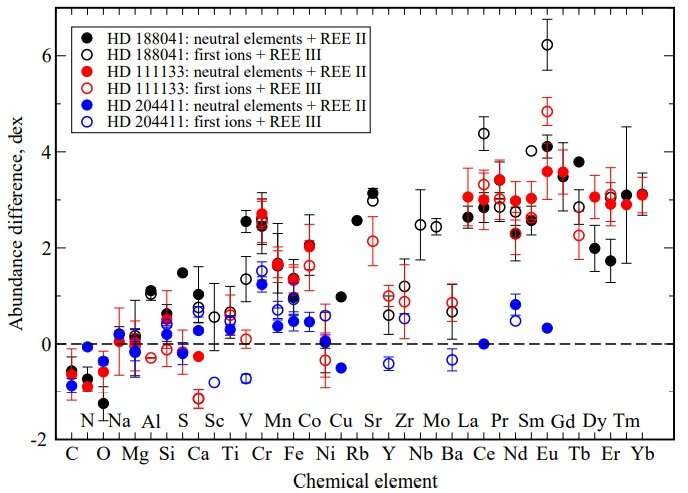July 17, 2019 report
Fundamental parameters, evolutionary status determined for three chemically peculiar stars

Astronomers have conducted spectroscopic observations of three magnetic chemically peculiar (CP) stars, HD 188041, HD 111133 and HD 204411. Results of these observations, presented in a paper published July 8 on arXiv.org, reveal fundamental parameters and the evolutionary status of the trio, also proving the usefulness of spectroscopy for studying faint CP stars.
CP stars are those with unusual metal abundances, thus exhibiting strong or weak spectral lines for certain elements. Some CP stars are observed to have stronger magnetic fields than classical A- or B-type stars, varying from few tens of Gauss to tens of kiloGauss, and are hence known as magnetic chemically peculiar stars (Ap and Bp stars). These class of objects is perceived by astronomers as a natural atomic and magnetic laboratory to study stellar formation and evolution.
However, studies of CP stars are challenging, mainly due to anomalous chemical composition of their atmospheres, which requires special analysis techniques. One such method is the self-consistent spectroscopic analysis, which allows astronomers to derive fundamental parameters of these stars like effective temperature, surface gravity, radius and luminosity.
Recently, an international team of astronomers led by Anna Romanovskaya of the Institute of Astronomy at the Russian Academy of Sciences employed this method to investigate three Ap stars: HD 188041, HD 111133 and HD 204411. The research, complemented by spectrophotometric observations over a wide wavelength range, gave the researchers insights into the parameters and evolution of these objects.
"In this work, we carried out a detailed atmospheric analysis of three Ap stars employing high-resolution spectroscopy and (spectro)-photometry calibrated to flux units," the astronomers wrote in the paper.
The research found that all the three stars show a large overabundance of iron and chromium in the deep atmospheric layers where high-excitation lines are formed. The astronomers noted that the most unusual result is deficiency of calcium throughout the whole atmosphere of HD 111133. This finding is surprising, as it was not predicted by the diffusion theory, and it requires further investigation.
According to the paper, HD 188041 has an effective temperature ranging from 8750 to 9250 K, while HD 204411 was found to be cooler—between 8,250 and 8,750 K. When it comes to HD 111133, the researchers estimate that its effective temperature is at a level of approximately 9,590 K.
With a radius of about 4.23 solar radii, HD 204411 turns out to be the largest star of the studied trio. The radius of HD 188041 is estimated to be around 2.26 solar radii, while HD 111133 is most likely from 2.92 to 3.44 times larger than our sun. The surface gravity for HD 188041 and HD 204411 was calculated to be at a level of approximately 4.0 to 4.5.
The astronomers found that HD 204411 has a relatively small magnetic field and is close to the end of its main-sequence life. By contrast, HD 111133 was found to possess a rather strong magnetic field, but is located close to the group of evolved stars.
Moreover, the authors of the paper emphasized that their study also demonstrates the importance of spectroscopic observations when it comes to studying faint Ap stars.
"We find a very good agreement between effective temperatures and radii derived by means of spectroscopy (employing model atmospheres) and interferometry (employing observed SED and radii derived from stellar angular diameters and parallaxes). It means that spectroscopically derived radii will provide us with rather accurate estimates of fundamental parameters for fainter Ap stars for which interferometric observations are not yet possible," the scientists concluded.
More information: A. Romanovskaya et al. Fundamental parameters and evolutionary status of the magnetic chemically peculiar stars HD 188041 (V1291 Aquilae), HD 111133 (EP Virginis), and HD 204411. Spectroscopy versus interferometry. arXiv:1907.03598v2 [astro-ph.SR]: arxiv.org/abs/1907.03598. PDF: arxiv.org/pdf/1907.03598.pdf
© 2019 Science X Network




















